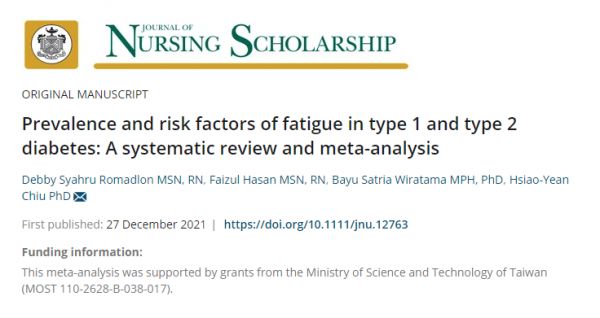1型和2型糖尿病疲劳的患病率和危险因素:系统评价和分析


Abstract
Purpose
This meta-analysis was conducted to determine the prevalence and risk factors of fatigue in type 1 and type 2 diabetes mellitus (DM).
Methods
Observational studies reporting the prevalence and risk factors of fatigue in type 1 or 2 DM were systematically searched for in PubMed, Embase, CINAHL Plus, Cochrane Trial, and ProQuest Dissertation and Theses databases. Data were extracted by two independent reviewers. A random-effect model was used for data analysis.
Findings
We included 19 studies involving 7131 patients with type 1 DM and 32 studies involving 34,994 patients with type 2 DM in the study. The pooled prevalence of fatigue in type 1 and type 2 DM was 44% and 50%, respectively. The Asia–Pacific region (e.g., Japan and Australia), South America, and Africa lacked reports regarding fatigue prevalence in type 1 DM, and North Asia and Southeast Asia lacked reports of fatigue prevalence in type 2 DM. Depression and physical activity were the only two variables significantly correlated with fatigue in both type 1 and type 2 DM (all p < 0.05).
Conclusions
Approximately half of the patients with type 1 or type 2 DM experienced fatigue, with the prevalence of 44% and 50%, respectively. Our findings regarding its risk factors can provide an evidence-based approach for managing fatigue in DM patients.
Clinical relevance
This meta-analysis emphasizes the importance of fatigue management in patients with type 1 and type 2 DM. Most significantly, our results on risk factors related to fatigue in diabetes can contribute to the development of evidence-based strategies for managing fatigue in individuals with DM.
摘要翻译(仅供参考)
目的
该荟萃分析旨在确定 1 型和 2 型糖尿病 (DM) 中疲劳的患病率和危险因素。
方法
在 PubMed、Embase、CINAHL Plus、Cochrane 试验和 ProQuest 论文和论文数据库中系统地搜索了报告 1 型或 2 型 DM 疲劳患病率和危险因素的观察性研究。数据由两名独立审查员提取。随机效应模型用于数据分析。
发现
我们纳入了 19 项研究,涉及 7131 名 1 型 DM 患者,32 项研究涉及 34,994 名 2 型 DM 患者。1 型和 2 型 DM 的疲劳总患病率分别为 44% 和 50%。亚太地区(如日本和澳大利亚)、南美和非洲缺乏 1 型糖尿病疲劳患病率的报告,北亚和东南亚缺乏 2 型糖尿病疲劳患病率的报告。抑郁和体力活动是唯一与 1 型和 2 型糖尿病患者的疲劳显著相关的两个变量(所有p < 0.05)。
结论
大约一半的 1 型或 2 型 DM 患者出现疲劳,患病率分别为 44% 和 50%。我们关于其风险因素的发现可以为管理 DM 患者的疲劳提供一种循证方法。
临床相关性
该荟萃分析强调了疲劳管理对 1 型和 2 型 DM 患者的重要性。最重要的是,我们关于糖尿病疲劳相关风险因素的结果有助于制定循证策略来管理糖尿病患者的疲劳。
本文由“健康号”用户上传、授权发布,以上内容(含文字、图片、视频)不代表健康界立场。“健康号”系信息发布平台,仅提供信息存储服务,如有转载、侵权等任何问题,请联系健康界(jkh@hmkx.cn)处理。
关键词:
患病率,糖尿病,分析,疲劳,评价,DM,数据,管理
相关知识
补充左旋肉碱对 2 型糖尿病患者减肥、血糖控制和心血管危险因素的影响:随机对照试验的系统回顾和剂量反应荟萃分析,Clinical Therapeutics
2型糖尿病
【海豚健康云】健康风险评估和健康危险因素分析系统
1型糖尿病
2型糖尿病餐后高血糖与心血管危险
危重症患者液体超负荷时使用袢利尿剂的优劣:随机临床试验荟萃分析和试验序贯分析的系统评价
2型糖尿病的运动疗法
2型糖尿病患者健康管理
糖尿病新药可降低心衰?2型糖尿病心衰的几率更大
健康管理人群2型糖尿病发病风险预测模型
网址: 1型和2型糖尿病疲劳的患病率和危险因素:系统评价和分析 https://m.trfsz.com/newsview729787.html